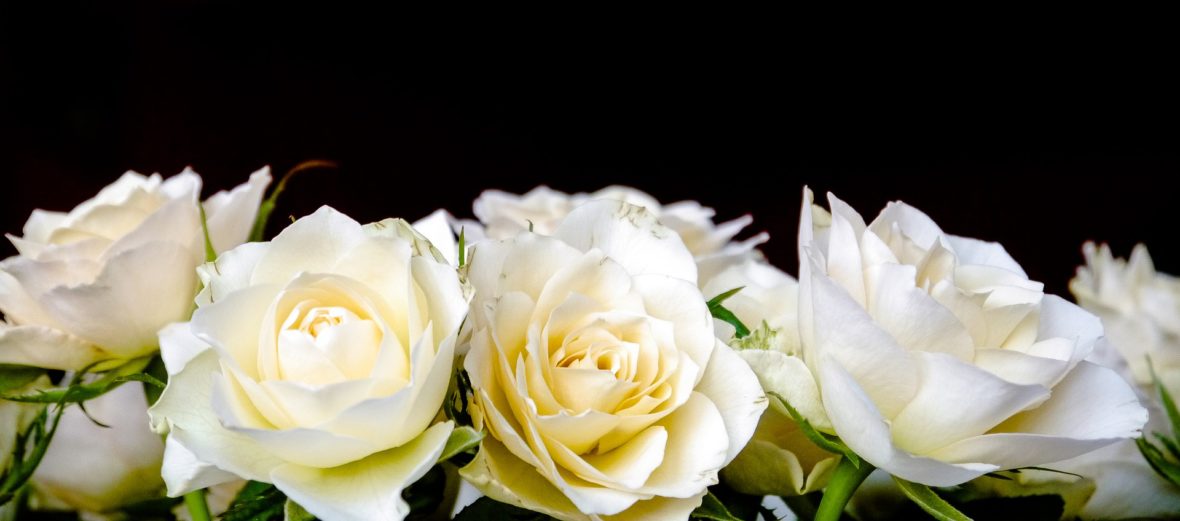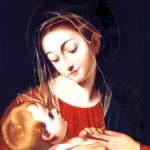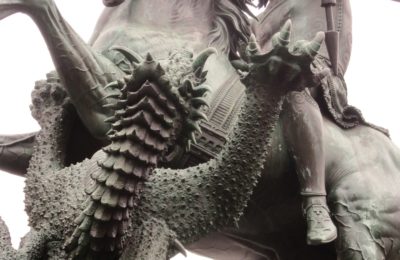“The Virgin may suitably be called a blooming rose. Just as the gentle rose is placed among thorns, So this gentle Virgin was surrounded by sorrow.” ~St. Brigid
The Blessed Virgin Mary is called The Flower of God, because of her Immaculate Conception, perpetual virginity, purity of life, and Divine motherhood. I first wrote a post about Our Lady and her relationship to flowers in June of 2019, here. Today’s post is a continuation of that theme.
Our Lady is The Flower that never faded, nor ever will. Gardens have been created all over the world to honor Our Lady as The Flower of God, and are called Mary Gardens. The tradition of building Mary Gardens is quite old, but waned a bit in modern times. The tradition is making a comeback, and in America it is largely due to the work of the Catholic gardener and writer, John Stokes, Jr. In the 20th century, Stokes poured a huge amount of personal effort into re-vitalizing the tradition of building Mary Gardens; including studying the history of flowers and painstakingly recording those named for the Blessed Virgin Mary. He also ran a seed business where he mailed out the appropriate seeds to start a garden to honor Our Lady. All of this was long before the internet and online shopping, so his efforts were quite remarkable. But how does one create a Mary Garden?
To create a Mary Garden, a few of the flowers named for Our Lady are planted around a statue or image of her. The garden might be small, as in an apartment window, or large. More information on Mary Gardens by Mr. Stokes may by found on the University of Dayton website as the University of Dayton possesses his library and collected works. But, why spend time learning Marian named flowers, and building a Mary Garden? Our time is limited, one might argue, and a garden seems a frivolous waste of time. Mr. Stokes answers such objections by presenting what he termed “blossom theology.” He wrote:
… all flowers were considered as symbols of Mary’s immaculate holiness, and that for this reason May, the month of flowering, was dedicated to Mary, the “Flower of flowers”, as she was called by Chaucer. Thus, all Flowers of Our Lady have a dual symbolism: while symbolizing particular facets of Mary’s life, mysteries and prerogatives through their forms, they are all at the same time, through their general characteristics as flowers, symbols of her immaculateness which enabled her reception of and participation in the bestowed mysteries and prerogatives.
In addition, certain flowers, plants and trees from the scriptures were adopted by the Church Fathers, and incorporated in the Liturgy, as specific Immaculate Conception symbols, such as the Blossoming Stem of Jesse from Isaiah’s prophecy of the Virgin Birth of the Messiah; and Rose Plant, Lily Among Thorns, Exalted Cedar, and Fruitful Olive Tree, from the Sapiential books. We can consider that such symbols were reflected on by Mary herself as she read the scriptures, in her spiritual formation. Later, other flowers were also adopted as Immaculate Conception symbols, such as Yucca, “Tower of Ivory”, from the Litany of Loreto.
We first showed a slide photo of the “Annunciation with Flower Symbols” from a 16th Century French Book of Hours – which exhibits a panel of individual symbolical flowers beneath a miniature painting of the Virgin Mary with the announcing Archangel Gabriel, a vase of white Annunciation Lilies, and the descending dove of the Holy Spirit.
Among these flowers are those which symbolize the maidenly, immaculate, purity of Holy Mary, through her openness and fidelity to the graces bequeathed her for the preservation of her Immaculate Conception:
White Lily: “Annunciation Lily”, symbol of Mary’s Immaculate Purity.
Impatiens: “Our Lady’s Earrings”, symbolical pure adornments of the ears of Mary who heard the word of God and kept it.
Violet: symbol of Mary’s humility “regarded by the Lord”.
Lady-Slipper: “Our Lady’s Slipper”, symbol of Mary’s graceful Visitation trip to visit Elizabeth in the hill country: “All her steps were most beauteous.”
Thistle-Down: another Visitation symbol, from its graceful movement in air currents.
Others symbolize some of Mary’s divinely bestowed prerogatives, as Mother of God, possible through her immaculate holiness:
Rose: symbol of the Blessed Virgin of prophecy, the Rose plant bearing the flower, Christ.
Daisy: “Mary’s Flower of God”
Periwinkle: “Virgin Flower”, emblem of the Blessed Virgin.
Columbine: symbol of the dove of the Holy Spirit, Mary’s overshadowing, indwelling, divine Spouse.
Pansy: “Trinity Flower”, symbol of the Trinity, first revealed to Mary.
Strawberry: “Fruitful Virgin”, in flower and fruit at the same time.
Everlasting: symbol of the eternity of Mary’s loving mediation in heaven.
Flower Symbols of Mary’s Divinely Bestowed Prerogatives
…Following the dogmatic definition of the doctrine of the Divine Maternity of Mary as the Mother of God at the Council of Ephesus in AD 432, the frontal image of the Mother and Child was adopted as its visual representation. In the English countryside the wild arum, with leaf-like spathe and rod-like pistil, was seen as a Virgin and Child symbol and commonly known to this day as “Lady-Lords”.
The Flowering Stem of Jesse (grape vine) – symbol of the virgin birth of the divine Redeemer from Isaiah – was extended to the blooming rose, as in the Christmas carol, “Lo a Rose ‘ere Blooming”. Other flowers of the Sacred Nativity include “Star of Bethlehem”; “Our Lady’s Bedstraw” – which, according to old legend, acquired its golden color when the glorious new-born divine Savior, true God and true Man, was laid on it in the manger – and “Our Lady’s Milkdrops”, also from legend and recalling, or anticipating, the Nursing Madonna in art.
The doctrine of Mary’s Perpetual Virginity, dogmatically defined in the twelfth century, was seen to be symbolized in the garden by the strawberry – in flower and fruit at the same time. Additionally there are numerous “Virgin’s” flowers.
Mary’s Transfixion as Co-Redemptrix with Christ is represented by “Mary’s Tears” and “Mary’s Sword” of sorrow, and by flower symbols of Christ’s Passion and Death on the Cross, in which Mary participated spiritually through motherly compassion, grace and union with the Lord, who was with her – such as “Crown of Thorns”, “Christ’s Lash”, “Christ’s Blood Drops”, “Christ’s Back”, “Christ’s Knee”, “Christ’s Cross” and the composite symbolism of the “Passion Flower”.
Besides the Assumption flowers previously mentioned, there is the white day lily, known as Assumption Lily from it’s mid-August bloom around the time of the August 15th liturgical feast of the Assumption. The marigold (“Mary’s Gold”), symbolizes the heavenly glory of Mary, the “Woman clothed with the Sun” of Revelations.
Mary’s prerogative of divine intercession was symbolized by “Mary’s Heart” – recalling the intercession of the Immaculate Heart of Mary with the Sacred Heart of Jesus, as scripturally implicit at the Marriage Feast in Cana.
Mary’s Mediation of All Grace – symbolized by flowers such as: “Our Lady’s Keys” (to the storehouses of heavenly grace), “Ladder to Heaven”, “Heavenly Way” and “Mary’s Candle” (“The Virgin Mary flies over all the land, with heaven’s fire in her hand”) – was scripturally implicit at the Visitation, when John the Baptist “lept” in Elizabeth’s womb on the arrival of Mary bearing Jesus in her womb; at the foot of the Cross, when the piercing of Mary’s faithful soul with the sword of sorrow, of Simeon’s prophecy, inspired (in John and through history) the grace-inspired love of Christ now revealed in many hearts; and Pentecost in the tongues and power of conversion conferred on the Apostles after nine days of prayers with Mary in the upper room.
Mary’s spiritual Motherhood was symbolized by flowers such as “Sweet Mary”, “Mary-Love”, “Mary’s Help”, “Eyes of Mary” suggesting her eyes of mercy, “Mary’s Hand” of pity”, and “Our Lady’s Mantle” protecting the faithful from evil.
And Mary’s queenly and motherly sorrow – as revealed at La Salette – over her children’s suffering from human delay in the coming of God’s Kingdom was symbolized by “Queen’s Tears”.
We then showed flowers symbolizing Mary’s other Rosary Mysteries, concluding with “Mary’s Crown”, of the glorious Mysteries.
Mr. Stokes demonstrates how the attributes of Our Lady are seen in flowers. It is, as Stokes said, that blossoms contain a certain theology and teach us. Mary Gardens honor Our Lady and Our Lord Jesus Christ, and teach of them. Such gardens are a part of Catholic culture, and their resurgence is wonderful. If we can build our own, within our homes or in our yards, we are doing our part to rebuild Christian civilization and culture.
As a final note, I find it interesting, and admirable, that our fellow Catholic, Mr. Stokes, accumulated all of this knowledge via personal study and investigation. If you wish to read more of his writing; it is found here. And, the following is a link on building your own Mary Garden, here.
May you have a good day.
~SCF







